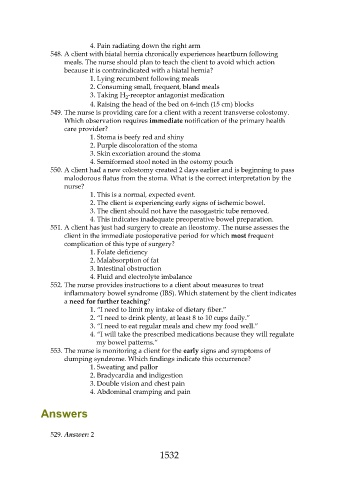Page 1532 - Saunders Comprehensive Review For NCLEX-RN
P. 1532
4. Pain radiating down the right arm
548. A client with hiatal hernia chronically experiences heartburn following
meals. The nurse should plan to teach the client to avoid which action
because it is contraindicated with a hiatal hernia?
1. Lying recumbent following meals
2. Consuming small, frequent, bland meals
3. Taking H -receptor antagonist medication
2
4. Raising the head of the bed on 6-inch (15 cm) blocks
549. The nurse is providing care for a client with a recent transverse colostomy.
Which observation requires immediate notification of the primary health
care provider?
1. Stoma is beefy red and shiny
2. Purple discoloration of the stoma
3. Skin excoriation around the stoma
4. Semiformed stool noted in the ostomy pouch
550. A client had a new colostomy created 2 days earlier and is beginning to pass
malodorous flatus from the stoma. What is the correct interpretation by the
nurse?
1. This is a normal, expected event.
2. The client is experiencing early signs of ischemic bowel.
3. The client should not have the nasogastric tube removed.
4. This indicates inadequate preoperative bowel preparation.
551. A client has just had surgery to create an ileostomy. The nurse assesses the
client in the immediate postoperative period for which most frequent
complication of this type of surgery?
1. Folate deficiency
2. Malabsorption of fat
3. Intestinal obstruction
4. Fluid and electrolyte imbalance
552. The nurse provides instructions to a client about measures to treat
inflammatory bowel syndrome (IBS). Which statement by the client indicates
a need for further teaching?
1. “I need to limit my intake of dietary fiber.”
2. “I need to drink plenty, at least 8 to 10 cups daily.”
3. “I need to eat regular meals and chew my food well.”
4. “I will take the prescribed medications because they will regulate
my bowel patterns.”
553. The nurse is monitoring a client for the early signs and symptoms of
dumping syndrome. Which findings indicate this occurrence?
1. Sweating and pallor
2. Bradycardia and indigestion
3. Double vision and chest pain
4. Abdominal cramping and pain
Answers
529. Answer: 2
1532

